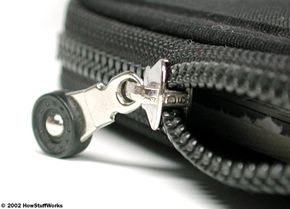Hook and Wedge
Zippers can only be manufactured using modern machines, but they are built around two of the oldest and simplest tools in the history of civilization: the wedge and the hook.
A wedge is just an object with a slanted (inclined) surface. If you push a wedge forward against an object, it will push the object to the left or right. In other words, the force exerted by a wedge is always perpendicular to the direction in which the wedge is moving. A door stop is a good example of this principle: When you shove it under a door, it applies an upward force on the bottom of the door. A plow is another common wedge -- when you drive it forward, it pushes dirt or snow to the sides.
Advertisement
A hook, of course, is a curved piece of material that can be used to grab onto another piece of material. Hooks have been used as fastening devices for thousands of years because they are simple and generally sturdy. When used as a fastening device, a hook is generally coupled with a loop, eye or hollow area, which receives the hook.
